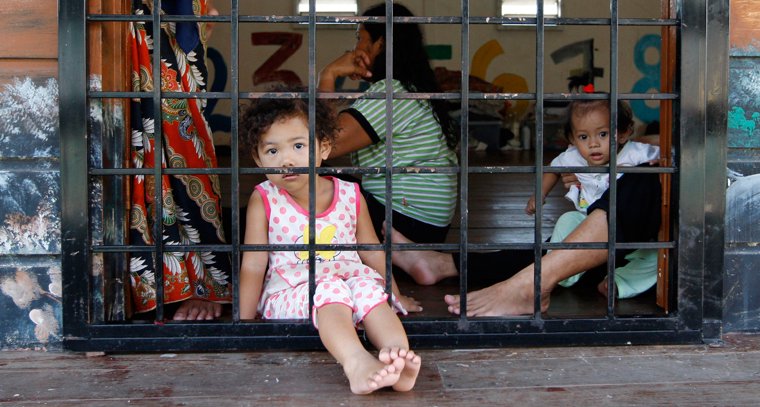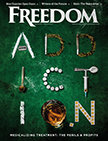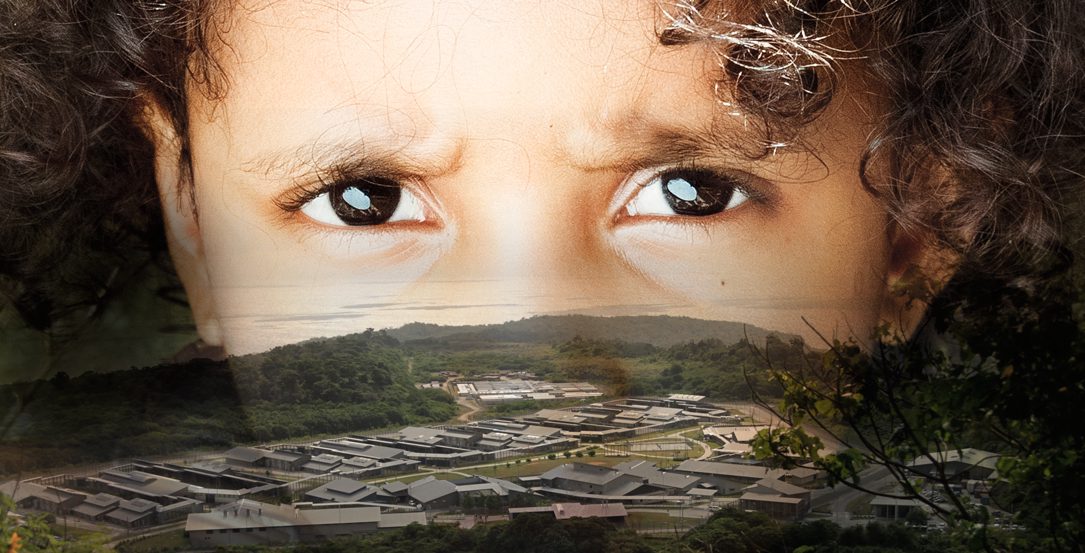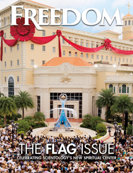No Asylum Here
An Australian human rights commission report exposes the plight of refugees—children and babies among them—held in prison-like detention, and highlights the crying need to move away from polarized political debates and toward a well thought out humanitarian response.
Despite its festive name, Christmas Island is no place for a celebration. Located roughly halfway between Singapore and Australia, the 50-square-mile island has long been a magnet for people fleeing wars, persecution or poverty in Asia, Africa and the Middle East. But far from being greeted with open arms, asylum seekers there are promptly whisked away to a high-security detention center that looks like a prison.
Living conditions at the detention center are so appalling that a year ago guards conducted “constant watches” outside 9-by-9-foot metal containers to prevent female detainees from killing themselves, according to the Australian Human Rights Commission (AHRC). Infants have little or no space to learn to crawl or walk in the stifling heat, and many detainees are “plagued by despair and helplessness.”
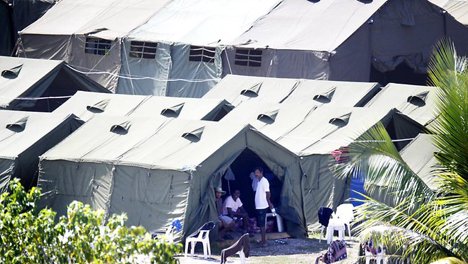
The AHRC is a statutory body whose inquiries are required by law to be presented to Australia’s parliament within 15 working days of being announced. And so it was that the AHRC created a political firestorm in November 2014 when it released a 320-page report about the long-term effects of immigration detention on 3,020 children from 20 countries. According to the report, at least 800 children, many of them with a history of torture or trauma, had been held in closed, indefinite detention for an average of 14 months.
One 14-year-old girl on Christmas Island compared her existence to a “bird in a cage.” At the Darwin Detention Center in mainland Australia, a boy, 13, said he felt like a criminal. “I am going crazy,” remarked a 15-year-old boy at the same facility. To protest their inhumane treatment, detainees burned down a detention center. Others sewed their lips together—an extreme way to go on a hunger strike.
Titled “The Forgotten Children: National Inquiry Into Children in Immigration Detention,” the AHRC report details widespread human rights abuses, including 33 cases of sexual assault on children in detention centers from January 2013 to March 2014.
As of February 28, Australia’s Department of Immigration and Border Protection identified a total of 35,067 men, women and children waiting under various programs for the government to process their asylum claims. As many as 1,737 people were held in prison-like detention, including 154 men on Christmas Island. And 107 children below the age of 18 were detained on Nauru, a tiny Pacific island nation so dependent on Australian aid money that it has allowed Australia to set up an immigration detention camp on its soil.
Many Australians were particularly shocked to learn that 167 babies had been born in detention, according to the AHRC report, and that not a single detainee had a “pathway to protection or settlement.” The AHRC has recommended that all children in detention be placed in community care, where they would, at the very least, enjoy freedom of movement. The commission has also proposed that Australia’s Parliament enact legislation to make the 1989 Convention on the Rights of the Child, a global standard aimed at the protection and development of all children, without discrimination, part of Australian law. Although Australia is one of the convention’s 194 members, its government has no mandate to follow the convention’s principles.
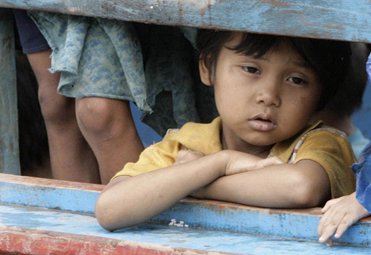
The AHRC report itself almost took second billing to drama as Australian Prime Minister Tony Abbott angrily rejected it, calling it a “blatantly partisan politicized exercise.” Without pointing to any factual errors in the report, Abbott accused AHRC Commissioner Gillian Triggs, who was appointed by the previous Labor government in 2012, of orchestrating a “transparent stitch-up” by releasing details of the inquiry less than 14 months after Abbot’s own coalition government came to power. (Triggs is an international lawyer whose first job was as an advisor to the chief of police of the Dallas Police Department regarding adoption of the 1964 Civil Rights legislation in the U.S.)
Abbott’s reaction was at odds with that of his own minister for Immigration and Border Protection, who had commissioned an independent review of the Nauru detention center and, in comments posted on a government website, remarked that the review “outlines some very disturbing matters, including drug dealing, sexual assault and rape.” Not only did the review confirm many of the AHRC’s allegations of sexual and physical assaults, but it noted “a level of under-reporting” of these crimes by detainees “for family or cultural reasons.”
As if the AHRC report hadn’t raised serious concerns about the legality and morality of locking up minors on remote islands practically devoid of social, medical and educational facilities, in March, United Nations Special Rapporteur on Torture Juan Mendez accused Australia of systematically violating the international Convention Against Torture by indefinitely detaining children and holding asylum seekers in dangerous and violent conditions.
Australia is the fourth-largest country of immigrant settlement in numbers over the past 150 years, after the U.S., Canada and Brazil. It is unique in its treatment of underage asylum seekers. “No other country mandates the closed and indefinite detention of children when they arrive on [its] shores,” wrote Triggs in her report—to the considerable embarrassment of many Australians.
The national mood was suitably captured by Arnold Zable, a writer and human rights advocate who was quoted in the media as saying that “no matter what one thinks, no matter what one’s view is, the fact that asylum seekers have become a political football is extraordinary in every way.”
A 2005 amendment to Australia’s 1958 Migration Act, which prohibits judicial oversight of mandatory detention, affirms the principle that children should be detained only as a last resort. And although successive Australian governments since 1992 have justified the mandatory detention of so-called “boat people” by claiming that it deters smugglers and prevents deaths at sea—more than 1,000 people, including at least 15 children, drowned while trying to reach Australia over a five-year period ending in 2013. The harsh practice “does not stop people coming to Australia to seek asylum,” according to the AHRC report.
The roots of mandatory detention with no foreseeable end date back to 1901, when Australia introduced the Immigration Restriction Act. It remained in force until 1958, and was used quite successfully to exclude non-European settlers in the official pursuit of a “White Australia” policy, which was based on the late-19th century eugenics movement of racial superiority.
Curiously, neither the Act of 1901 nor its 1958 successor mentions race or the White Australia policy that has been dead for nearly half a century. “This illuminates one of the stranger features of Australian immigration policy: the consistent denial by officials of something which everyone knows to be true—from ‘There is no racial discrimination’ to ‘Detention centers are not prisons,’” writes James Jupp, a migration scholar at Australian National University, in his 2002 book, From White Australia to Woomera: The Story of Australian Immigration. (Woomera is a remote desert town and weapons testing range where Australian authorities detained Afghan, Iraqi and Iranian asylum seekers in 2002.)
Many Australians were particularly shocked to learn that 167 babies had been born in detention and that not a single detainee had a pathway to protection or settlement.
Globalization and religion have played significant roles in Australia’s attitude toward immigrants and asylum seekers. The September 11, 2001, attacks in America served to remind Australians about the costs of giving up too much control of the nation’s borders. “There’s this feeling in Australia that we can somehow keep away from the dangers of the world, even in the age of globalization, by fiercely controlling our borders,” says Anthony Moran, a senior lecturer in the College of Arts, Social Science and Commerce at La Trobe University in Melbourne. “We’ve had some incidents of terrorism, and some groups argue that we should maintain an immigration program but [not] allow Muslims.”
It hardly helps the cause of asylum seekers languishing in Australian lockups that they’re mostly from the Islamic republic of Iran, according to AHRC statistics. The second-largest group has identified itself as “stateless”—and most happen to be Rohingya Muslims fleeing longtime persecution by the military regime in Myanmar.
Human rights activists agree across the board that Australia’s mandatory detention law is all the more inhumane in light of a striking fact: It’s the only developed Western nation that does not have constitutional or legislative protections enshrined in a Bill of Rights to enable its courts to protect refugees, says Hilary Charlesworth, director of the Center for International Governance and Justice at the Australian National University in Canberra.
“In international law, once a country is faced with claims of refugee status, that country is no longer in the realm of immigration but in the realm of human rights,” says Charlesworth.
Charlesworth’s insight echoes a point Triggs alluded to in a 2012 interview as the incoming AHRC commissioner. Asked what her biggest challenge would be in her new job, Triggs replied that she wanted to achieve a closer understanding and integration of international human rights standards in Australian law as well as in the country’s day-to-day life.
Historically, every government in Australia has made a clear distinction between refugees fleeing tyranny and those merely trying to escape poverty. Like other Western nations during the 1970s, Australia offered sanctuary to refugees from regions as distant as Central America and Chile. It accepted waves of asylum-seekers fleeing the Vietnam War in 1975 as well as victims of Indonesian oppression in Timor. Over the years, political debates on immigration have revolved around criminal traffickers who try to ship would-be refugees to Australia for a fee, thereby casting them in the popular imagination as queue-jumping economic migrants.
“That’s ironic because we were a penal colony—we all arrived without documents,” says Grant Mitchell, director of the International Detention Coalition (IDC), a Melbourne-based international human rights network that has offices in 73 countries. “We also have this legacy of paranoia about people who look different.”
To be fair, it’s hard to tell exactly where the roots of Australia’s paranoia lie, given that the nation still accepts 15,000-20,000 refugees annually and that the number of asylum seekers headed for Australia over the decades is relatively small compared to those who end up in Europe and the U.S. Attempts to enter Australia illegally peaked in 2013, according to the AHRC report, largely as a result of the unrest caused by the Arab Spring, which forced people to flee Syria, Iran, Afghanistan and Somalia.
The AHRC quoted the United Nations High Commissioner for Refugees as saying that there were 16.7 million refugees globally by the end of 2013. “Half of those refugees were children, the highest figure in 10 years,” the AHRC report noted. During fiscal 2012-13, Australia resettled 12,515 refugees—less than 1 percent of the million-plus applications for asylum submitted worldwide in 2013, according to the report.
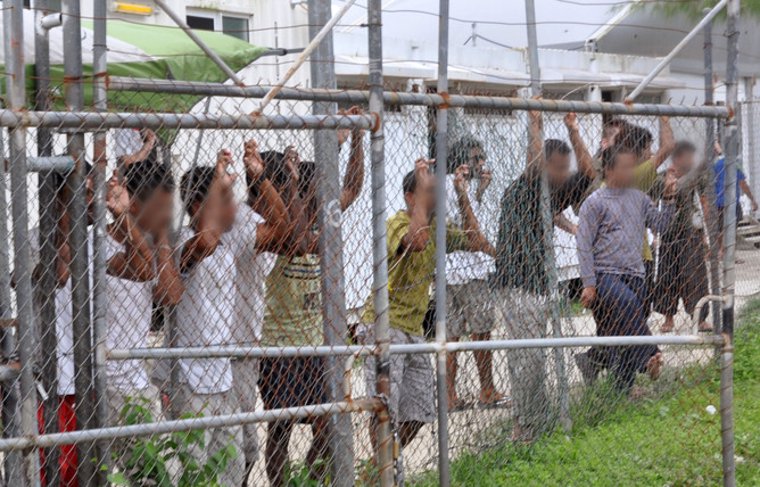
Australia has coped with the changes in global migration patterns by coming up with the so-called Pacific Solution. Devised around the turn of the millennium, when more than 8,000 people arrived on boats to Australian shores over a three-year period ending in 2001, the highly controversial strategy revolves around treaty agreements with neighboring nations such as Indonesia, the world’s largest Muslim nation, where refugees can be repatriated. (A similar treaty last year to outsource Australia’s refugee crisis to Cambodia by paying the impoverished and notoriously corrupt nation tens of millions of dollars was a particularly low point.)
“It’s like Australia is this continent that can protect itself from illegal immigrants in a way the U.S. can’t,” says La Trobe University’s Moran. “Australia has a fairly strong sense of national pride and feelings of attachment to the country, which have occurred at a time when the national identity has shifted from ‘White Australia’ to a more multicultural identity.”
Australia helped draft the Refugee Convention, and yet we’ve done everything to make it impossible for refugees to settle here.
For the past 15 years or so, in tandem with instability across the Middle East as well as in Myanmar and Sri Lanka, consistent waves of people have approached Australia and Europe. But there’s one crucial difference between Australia’s response to the crisis and that of European nations: “It’s a challenge, but the Italians have been patiently processing the claims of thousands of refugees,” says IDC’s Mitchell. “What we’re seeing in Australia is a policy of using islands we have no sovereignty over to block access to Australia.”
By mid-2005, Australia had released all children from complete detention on its own soil, with help from the Red Cross. The children were put in community detention, where they were assigned “case managers” and were relatively free to move around. “But the Abbot government has continued the earlier policy,” which limits the rights of appeal of those detained in offshore facilities, says Mitchell, adding: “There has been a constant back-and-forth to get a bipartisan commitment to end detention once again.”
By all accounts, asylum seekers to Australia appear to be caught between the proverbial rock and a hard place. Their predicament is all the more poignant because many people fleeing wars or poverty don’t necessarily want to come to Australia, as Mitchell puts it. Part of the reason why they feel compelled to make Australia their destination is that unlike many of its Asian neighbors, such as Indonesia, Malaysia and Thailand, Australia is a signatory to the 1951 Refugee Convention.
Under the convention, refugees have a number of rights, most significantly the right to non-refoulement, that is, not to be returned to a country where they face serious threats to their lives or freedom. “There’s no protection for these refugees in Indonesia or Myanmar, where they can be jailed,” explains Mitchell, adding: “Their target is freedom and safety—permanent protection.”
By denying people access on every level, Australia is setting “a very bad example for the rest of the world,” says Mitchell. “We helped draft the Refugee Convention, and yet we’ve done everything to make it impossible for refugees to settle here.”
Many Australians agree that there’s a crying need to end the polarized political debate focused on “turning back the boats” and begin a well thought out humanitarian response.
“From the human rights perspective, we’ve just pushed the problem back to countries that are completely incapable of dealing with human rights issues,” says Charlesworth. “While I’m not very optimistic about the political debate changing, the system is clearly not appropriate—and that’s what needs to be addressed.”
